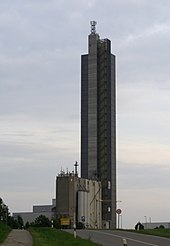Schapfenmühle
| SchapfenMühle GmbH & Co KG
|
|
|---|---|
| legal form | GmbH & Co. KG |
| founding | 1452 |
| Seat | Ulm , Germany |
| management | Ralph Seibold |
| Number of employees | 175 (2014) |
| sales | 61.7 million euros (2013) |
| Branch | Milling products |
| Website | www.schapfenmuehle.de |
The Schapfenmühle is a flour mill in Jungingen , a northern district of Ulm on the southeastern edge of the Swabian Alb . It was first mentioned in a document in 1452, making it the oldest still manufacturing company in the city of Ulm.
Mill
Today's mill in Ulm-Jungingen was completed in 1985 after the mill at the original location at the Weinhof in Ulm's fishing district fell victim to a fire on Whit Sunday 1983. It has a grinding capacity of around 100 tons in 24 hours. In 1991 the mill was expanded to include a peeling mill, which also peeled around 100 tons of grain per day. The grain comes from around 500 farms within a 50 to 60 km radius. All types of grain are processed. The products include flours, flakes of all types of grain and baking mixes. A mixing plant and a test bakery are connected to the mill.
Grain silo
The grain silo of the Schapfenmühle was built between June 2004 and January 2005 and has a floor area of 10.1 × 16.7 m², a height of 116 m to the top of the building and almost 125 m including the antenna mast of the mobile operator E-Plus . This makes it the second tallest grain silo in the world, after the then 120 m high Henninger Tower in Frankfurt am Main was demolished in 2013. Only the Swissmill Tower in Zurich is higher at 118 m to the top of the building. The local office Seidel Architekten is responsible for the design of the silo. In Ulm, the silo tower, which was nominated for the German Architecture Prize in 2005, is the third tallest structure and the second tallest building (next to the Ulm-Ermingen telecommunications tower with 162 m and the Ulm Minster with 161.53 m).
Around 8,500 tons of grain can be stored in 30 cells inside the tower. The intake capacity is 120 tons per hour. The facade on the south side is provided with a photovoltaic system consisting of 1300 CIS solar modules , which produces around 70,000 kWh of electricity annually. However, thanks to the vertical installation, the system only produces around 70 percent of the theoretically possible yield.
The total cost of the building was 6.24 million euros, of which 1.56 million euros were taken over by the state of Baden-Württemberg due to the expected improvement in the market structure .
Individual evidence
- ↑ The tallest granary in the world. In: Allgemeine Bäcker-Zeitung. No. 17, April 30, 2005, p. 7
- ↑ More than flour ( Memento from April 12, 2013 in the web archive archive.today )
- ↑ The tallest granary in the world is in Zurich. Report on watson.ch, September 14, 2015
- ↑ InformationsZentrum Beton: Tower in sliding construction - Grain silo Zur Schapfenmühle in Ulm , accessed on August 5, 2019.
- ↑ Seidel: Architects: Industriebau: Silo Building - A tower at the city entrance , accessed on August 5, 2019.
- ^ Project website from Seidel: Architects
- ↑ Aiming high with solar energy. In: Lighthouse projects for the use of renewable energies in Baden-Württemberg. Ministry of the Environment Baden-Württemberg, Stuttgart 2007, p. 15
- ↑ Electricity from the slide. In: Spiegel Online . May 12, 2007
- ↑ ( Page no longer available , search in web archives: Grain from the region has right of way ). Press release from the Ministry of Food and Rural Areas Baden-Württemberg. April 15, 2005
Web links
Coordinates: 48 ° 25 ′ 57 ″ N , 9 ° 58 ′ 58 ″ E


